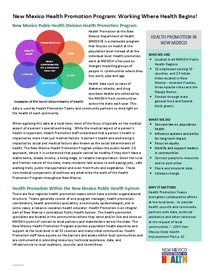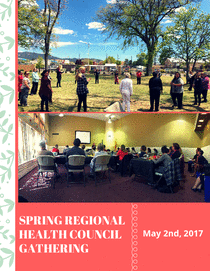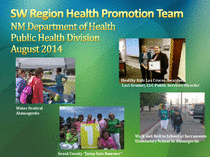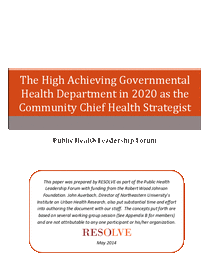Health Promotion
Publications
 Health Promotion 2018 Executive Summary
Health Promotion - Report
September 27, 2018
Health Promotion 2018 Executive Summary
Health Promotion - Report
September 27, 2018
This executive summary is designed to showcase the diverse ways health promotion staff work with local partners to build capacity, address identified public health goals and objectives, enhance overall community health improvement through collaboration and community organizing, while highlighting that health promotion activities are based upon sound scientific data and research.
 Health Promotion Spring 2017 Health Council Gathering
Health Promotion - Meeting
June 22, 2017
Health Promotion Spring 2017 Health Council Gathering
Health Promotion - Meeting
June 22, 2017
On May 2nd, the Northeast Region Health Promotion Team, the New Mexico Alliance of Health Councils, and the New Mexico School for the Deaf hosted a gathering for the health councils and community members in the Northeast Region of the state.
 Defining and Analyzing a Health Problem
Health Promotion - General
August 28, 2014
Defining and Analyzing a Health Problem
Health Promotion - General
August 28, 2014
This is an exercise with which to practice the Assessment Process for the problem of Excessive Drinking (alcohol) for your county. You will work in groups of five persons. You may each be from different counties.
 Define, Analyze & Prioritize Community Health Problems
Health Promotion - Presentation
August 28, 2014
Define, Analyze & Prioritize Community Health Problems
Health Promotion - Presentation
August 28, 2014
This training will emphasize the critical link between community health data and community assessment and prioritization, expose HPS to the Community Tool Box, a resource for Community Health Improvement capacity building, and introduce methods and techniques for analyzing health problems and prioritizing health problems.
 Collective Impact: A Framework for Large-Scale Social Change
Health Promotion - Presentation
August 28, 2014
Collective Impact: A Framework for Large-Scale Social Change
Health Promotion - Presentation
August 28, 2014
This presentation explains what collective impact is, how to build backbone support, the three phases of collective impact, the strive together approach, the four pillars of drive’s theory of action, and a wealth of information about mission: graduate.
 Health in All Policies Presentation
Health Promotion - Presentation
August 28, 2014
Health in All Policies Presentation
Health Promotion - Presentation
August 28, 2014
Intersectional collaboration to improve community health and equity. This presentation covers a brief summary of social determinants of health, strategies to implement health in all policies, identifying opportunities for cross-sector collaboration, and how all this connects.
 Southwest Region Health Promotion Team
Health Promotion - Presentation
August 28, 2014
Southwest Region Health Promotion Team
Health Promotion - Presentation
August 28, 2014
This presentation gives an overview of the Southwest health promotion team vision, mission, team principles, areas of expertise, strengths, the 10 public health essential services, health lifestyle priority, behavioral health and substance abuse prevention, community capacity building, capacity developed, opportunities and plans.
 High Achieving Governmental Health Department in 2020
Health Promotion - General
August 7, 2014
High Achieving Governmental Health Department in 2020
Health Promotion - General
August 7, 2014
Local and state health departments need to adapt and evolve if governmental public health is to address emerging health demands, minimize current as well as looming pitfalls, and take advantage of new and promising opportunities. To succeed requires a view into the future. This paper provides that vision.
 Health in All Policies Guide
Health Promotion - Guide
August 7, 2014
Health in All Policies Guide
Health Promotion - Guide
August 7, 2014
Health in All Policies is a collaborative approach to improving the health of all people by incorporating health considerations into decision-making across sectors and policy areas. This paper provides: a discussion of the concept of Health in All Policies, the “nuts and bolts” of this work, and a case study of the California Health in All Policies Task Force.

